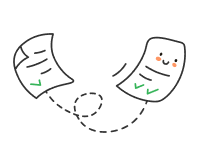Content
- Introduction
- Who is in charge of HR records management in the company?
- HR records management at your company: what does the law stipulate?
- What HR documents do you need to have in your company?
- How to start organizing HR records management?
- Coordination/interaction with other company departments
- Signing of HR documents
If there is at least one employee in a company, a labor relationship is established between him/her and the employer. According to the law, they must be documented. This means that any company has to deal with HR documents.
As a business scales, their volume increases. At this stage, forward-looking companies are seeking optimization to make their HR records management as efficient as possible.
How do companies organize HR records management? What documents should your company have according to the law? Let’s discuss this in the article.
Who is in charge of HR records management in the company?
HR records management issues within the company are handled by a single person — an HR specialist or HR manager. He/she is appointed to the position by an order of the director.
In companies with large staffs, these issues are handled by a separate structural unit — the HR department. Its size depends on the size of the company and the tasks assigned to it.
To organize the HR department, the company issues a regulation. It specifies the tasks of the department, its structure, rights, responsibilities and forms of interaction with other departments.
HR records management at your company: what does the law stipulate?
HR records management helps you document the company’s processes related to its employees. In particular, the HR department documents the following:
- recruitment, registration of vacations, transfers to other positions, business trips, dismissals, etc;
- accounting of employees;
- internal regulations;
- staff work time logging;
- employment position instructions;
- reports to state authorities, etc.
HR records management is about organizing work with HR documents related to recruitment, transfer, dismissal, accounting, certification, training, professional development, and pension provision for employees.
Since the beginning of the full-scale war, there have been some legislative and HR records management changes. HR employees must keep track of them to comply with the requirements of the current legislation.
There are periodic changes in the laws and HR records management, so HR employees must keep track of them to comply with the requirements of the current legislation. This will help avoid any labor disputes with employees and fines imposed by the state.
In particular, HR employees should consider the requirements of the following regulatory instruments:
| Labor Code of Ukraine | Main requirements for legal relations between the company and employees |
| The Law of Ukraine “On Remuneration of Labor” | Regulations on remuneration of employees |
| The Law of Ukraine “On Vacations” | Regulations on vacation provision |
| Dictionary of Occupational Titles DK 003:2010 | The current list of professions defining qualification requirements for employees |
| Rules for Organization of Records Management and Archival Storage of Documents in State Authorities, Local Self-Government Authorities, Enterprises, Institutions and Organizations No. 1000/5 | Requirements for the preparation of administrative documents and work with official documents, as well as the procedure for their storage at enterprises |
| List of standard documents No. 578/5 | Retention periods for documents, including HR documents |
| Order №1886/5 | Requirements for organizing work with electronic documents in records management and preparing them for archival storagе |
What HR documents do you need to have in your company?
HR documents are documents that contain information about the company’s personnel. Let’s take a closer look at which HR documents are mandatory for the company.
According to the law, the company must keep the following HR documents:
- staffing table — position titles are consistent with the Dictionary of Occupational Titles DK 003:2010;
- internal labor regulations;
- time sheets;
- orders on HR issues — these include orders with a long retention period (75 years or more) and a temporary retention period (up to 5 years);
A register of orders (a log book of orders); - personal cards of employees according to the form No. П-2;
- vacation schedule;
- employment agreements (contracts);
- collective employment agreement (for legal entities);
- employment position descriptions;
- a log book on employee familiarization with internal regulations;
- regulations on labor protection;
- permission to personal data processing;
- non-disclosure obligations.
The list of documents used in HR records management is constantly updated to reflect changes in legislation. In addition, in their day-to-day work, HR employees prepare documents to support the company’s HR processes.

How to start organizing HR records management?
HR work is a labor-intensive process. Ukrainian legislation does not distinguish between HR records management by individual entrepreneurs and legal entities, so all companies with employees must manage HR documents, regardless of the size of their business.
With the expansion of the staff, the HR document workflow increases. The number of processes that need to be arranged also grows: onboarding new employees, registering vacations and sick leaves, transferring to other positions, dismissals, etc. At this stage, the company faces the need for an efficient HR records management system.
First of all, the HR department needs to analyze the HR processes in the company and determine what documents they require.
| HR processes | HR documents |
| Recruitment |
|
| Transfer to a different position |
|
| Vacation registration |
|
| Звільнення |
|
Coordination/interaction with other company departments
The HR department interacts with other departments of the company while working.
In particular, with the accounting department when it comes to documenting processes related to payments or tax reporting. For example, when arranging a business trip, the HR department prepares an order, and then the accounting department calculates the number of per diems on its basis.
Executives of the company coordinate recruitment, transfer and dismissal of employees with the HR department. Together with the legal department, HR officers monitor compliance with labor laws.
Since HR processes affect all departments of the company, the HR department interacts with all of them.
Signing of HR documents
The company’s internal policy determines who approves and signs HR documents. For example, in some companies, a resignation letter is approved only by the employee’s immediate supervisor, while in others, it is approved by managers of other levels. Other documents are approved by the company’s lawyer, chief accountant, etc.
To simplify this process, employees can approve and sign HR documents electronically. For example, the Vchasno service allows you to set the approval procedure and deadlines for the signing of documents. An employee of the company applies an electronic signature to the document, which takes only a few seconds.
HR records without paperwork and hassle
Optimize HR department time, create applications in a few clicks, and process documents efficiently in Vchasno.Kadry






